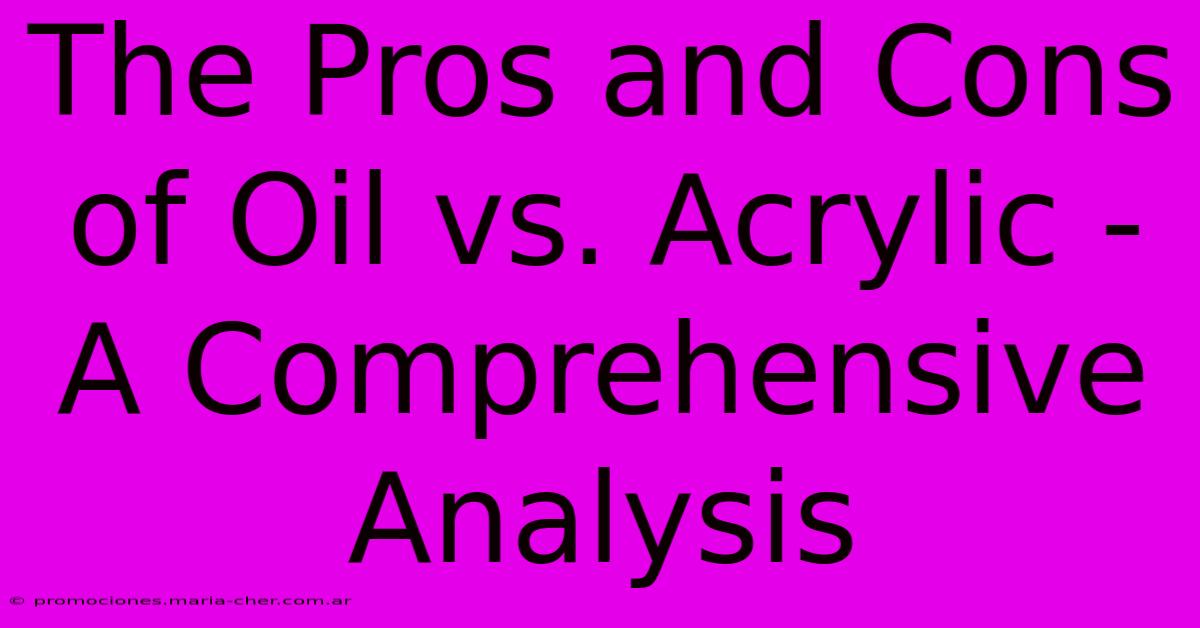The Pros And Cons Of Oil Vs. Acrylic - A Comprehensive Analysis

Table of Contents
The Pros and Cons of Oil vs. Acrylic - A Comprehensive Analysis
Choosing between oil and acrylic paints can feel like a monumental decision for artists of all levels. Both mediums offer unique properties and advantages, making the "best" choice entirely dependent on your individual style, goals, and working environment. This comprehensive analysis will delve into the pros and cons of each, helping you make an informed decision.
Oil Paints: The Timeless Classic
Oil paints have reigned supreme in the art world for centuries, prized for their rich colors, luminosity, and versatility.
Pros of Oil Paints:
- Rich, Vibrant Colors: Oil paints boast an unparalleled depth and richness of color, capable of producing stunningly luminous effects. The slow drying time allows for exquisite blending and layering.
- Blending Capabilities: The extended drying time is a double-edged sword, but a significant advantage for blending. Artists can seamlessly transition between colors, creating smooth gradients and subtle variations.
- Glazing and Layering: The slow drying process allows for complex glazing techniques, where thin layers of transparent color are applied over dried layers, building depth and complexity.
- Permanence: Oil paints are known for their exceptional archival quality, with properly cared for paintings lasting for centuries.
- Texture and Impasto: Oil paints are highly versatile in terms of texture. Thick impasto techniques, where paint is applied thickly, are easily achievable.
Cons of Oil Paints:
- Slow Drying Time: This can be both a blessing and a curse. While excellent for blending, it necessitates careful planning and longer project timelines. Solvents are often necessary to thin the paint or clean brushes, introducing additional health and environmental considerations.
- Odor: Oil paints and solvents produce strong odors, requiring good ventilation in your workspace.
- Cleanup: Cleaning oil paint brushes requires solvents, making the process more involved and potentially hazardous.
- Cost: Oil paints and the necessary mediums and solvents tend to be more expensive than acrylics.
- Toxicity: Some oil paints and solvents contain toxic substances, demanding careful handling and proper disposal.
Acrylic Paints: The Modern Marvel
Acrylic paints have rapidly gained popularity due to their convenience, versatility, and relative affordability.
Pros of Acrylic Paints:
- Fast Drying Time: This is a major advantage for artists who prefer quick results or work on multiple pieces simultaneously. It also simplifies the cleaning process significantly.
- Water-Based: Acrylics are water-based, making cleanup significantly easier using just soap and water. This reduces the need for hazardous solvents.
- Versatility: Acrylics can be used on a wide range of surfaces, including canvas, wood, paper, and fabric.
- Affordability: Acrylic paints are generally less expensive than oil paints.
- Easy Cleanup: Cleanup is simple and straightforward, requiring only soap and water.
Cons of Acrylic Paints:
- Fast Drying Time: While convenient, the rapid drying time can make blending challenging and limit the ability to achieve the same subtle gradations as oil paints.
- Less Vibrant Colors: Compared to oils, acrylics generally possess a less intense and luminous quality.
- Limited Layering and Glazing: The quick drying time makes glazing and layering more difficult.
- Less Forgiveness: Mistakes are harder to correct due to the rapid drying time.
- Potential for Cracking: Improper application or preparation can lead to cracking over time.
The Verdict: Which Paint is Right for You?
Ultimately, the "best" paint depends entirely on your individual preferences and working style. Consider these factors:
- Your Artistic Style: Do you prioritize smooth blending and rich colors? Oils may be preferable. Do you prefer speed and convenience? Acrylics might be a better choice.
- Your Budget: Acrylics are more affordable.
- Your Workspace: Do you have adequate ventilation? Oil paints require well-ventilated spaces due to the strong odors and solvents.
- Your Experience Level: Beginners might find acrylics easier to work with due to the easier cleanup and faster drying time.
Whether you're an experienced artist or just starting out, understanding the pros and cons of oil and acrylic paints empowers you to select the medium that best suits your creative vision. Experiment with both to discover which resonates most with your artistic soul!

Thank you for visiting our website wich cover about The Pros And Cons Of Oil Vs. Acrylic - A Comprehensive Analysis. We hope the information provided has been useful to you. Feel free to contact us if you have any questions or need further assistance. See you next time and dont miss to bookmark.
Featured Posts
-
The Scars Of Unity The Red And Black Scarf As A Witness To A Nations Struggles
Feb 10, 2025
-
Transform Your Manis With Dnd Nail Glue The Ultimate Nail Bonding Solution
Feb 10, 2025
-
Precision Meets Performance Discover The I1 Pro Colorimeters Unmatched Capabilities
Feb 10, 2025
-
Escape The Urban Jungle Discover The Serenity Of Detroits Grand Circus Park
Feb 10, 2025
-
Detroits Iconic Landmark Cobo Halls Hidden History Revealed
Feb 10, 2025
